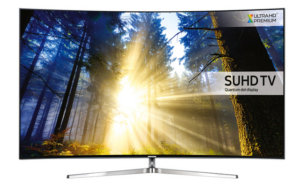John Archer is a writer for Forbes, specialising in home entertainment technology. Recently, he reviewed Samsung’s 55″ KS9500 TV – not a flagship SUHD model, but still a new set for 2016. In the process, Archer discovered issues with Samsung’s edge lighting that, combined with HDR, have a negative impact on the viewing experience.
In recent generations of TVs, Samsung’s edge-lit sets have used a horizontal lighting system: the LED strips are set along the left and right sides of the display. The backlight is said to be easier to control using this design. However, the KS9500 is an UltraHD Premium-certified set, and Samsung had to make some changes to reach the 1,000 cd/m² peak brightness level specified. One of these changes was switching to a vertical lighting system, where the light fires from the top and bottom of the screen.
The problem with the vertical lighting system is that it can lead to ‘stripes’ of excess light pollution around very bright parts of the image. The effect is especially obvious if watching content filmed with a wide aspect ratio, which is shown letterboxed, with black bars above and below the image. These bars, says Archer, will show extra levels of brightness, which can be distracting. The brightness tone of the bars – and, indeed, the entire image – was also found to shift ‘quite dramatically’ in transitions from very dark to very bright shots, or vice versa.
In addition to the above, Archer found that there are sometimes obvious light stripes or inconsistencies around very bright objects in the main frame.
Issues with the KS9500’s backlight are most noticeable when watching mostly dark scenes with lots of motion: the opening scenes of Mad Max: Fury Road, where Max is escaping from his captors in a cave, was cited as an example.
There are ways to get around the issue. While the KS9500 automatically changes the settings of its picture presets when it detects an HDR source, it does not lock a user to these settings – unlike the 2015 TVs. Turning off local dimming is one way to reduce potential distractions, as is lowering backlight brightness, although these will also affect the picture quality.

